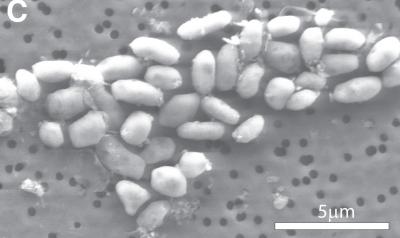
Science/AAAS
Fifteen years after publishing an explosive but long-criticized paper claiming to describe a microbe that could substitute arsenic for phosphate in its chemical makeup, Science is retracting the article, citing “expanded” criteria for retraction.
The authors stand by their findings and disagree with the retraction, and contend the decision doesn’t reflect best practices for publishers.
Many scientists, including David Sanders, a biologist at Purdue University in Lafayette, Ind. who has previously argued for the paper’s retraction in posts for Retraction Watch, believe the paper’s results were simply the result of contamination of the authors’ materials. He told us he was “glad” to see the retraction.
“The problem was not that later research undermined the conclusions,” Sanders said. “The problem was that the evidence presented in the article was not supportive of the conclusions from the start and that all the results were based on the fact that the arsenate was contaminated with phosphate.”
While the retraction notice does not explicitly state the contamination concern as a reason for the retraction, a blog post by the journal’s editors does.
The retraction has been in the works since at least last October, after a reporter for The New York Times contacted the journal for a story about Felisa Wolfe-Simon, the lead author of the study who withdrew from science after becoming the target of intense online criticism.
The article appeared in December 2010, and immediately attracted scrutiny for its methodology, as well as complaints about how Science and NASA, where some of the authors worked, handled publicity for the work. NASA announced a press conference “to discuss an astrobiology finding that will impact the search for evidence of extraterrestrial life.” Meanwhile, Science refused to lift its embargo on the paper despite feverish online speculation NASA scientists had discovered aliens.
The paper has been cited 326 times, according to Clarivate’s Web of Science. Those citations include eight “technical comments,” the authors’ response, and an editors’ note that appeared six months after initial publication. Two papers from 2012 describe unsuccessful attempts to replicate the findings.
Despite publishing so many formal critiques, the journal did not retract the paper in 2012, “because at that time, Retractions were reserved for the Editor-in-Chief to alert readers about data manipulation or for authors to provide information about postpublication issues,” according to the retraction notice, signed by editor in chief Holden Thorp. The editors believed, then and now, “there was no deliberate fraud or misconduct on the part of the authors,” wrote Thorp, who was not the editor of the journal when it published the article.
But now, the journal’s “standards for retracting papers have expanded,” Thorp wrote. “If the editors determine that a paper’s reported experiments do not support its key conclusions, even if no fraud or manipulation occurred, a Retraction is considered appropriate.”
Sanders said a retraction of the paper “was always warranted” if “a fundamental error undermines a substantial part of an article or a major conclusion.”
The retraction notice acknowledged receiving “media inquiries” about the article, “highlighting the extent to which the paper is still part of scientific discussions.” Based on the previously published critiques, the journal editors decided the article “meets the criteria for retraction by today’s standards,” Thorp wrote.
In a blog post published along with the retraction, Thorp and Valda Vinson, executive editor of Science, went into further detail:
One of the Technical Comments had pointed out that the nucleic acids that were analyzed were not sufficiently purified before the acquisition of spectra that suggested the presence of arsenic. Given the evidence that the results were based on contamination, Science believes that the key conclusion of the paper is based on flawed data.
The journal’s peer review process and editorial decisions “led to the publication of a paper with seriously flawed content,” Vinson and Thorp wrote. “With this retraction—and with all retractions and corrections—we acknowledge and take responsibility for the role that we played in the paper’s publication.”
Most of the authors signed a letter objecting to the retraction, which Science also published.
“While our work could have been written and discussed more carefully, we stand by the data as reported,” they wrote. “These data were peer-reviewed, openly debated in the literature, and stimulated productive research.”
The authors charged Science had overstepped guidelines from the Committee on Publication Ethics (COPE) on retractions, as “no misconduct or error is alleged.”
“Disputes about the conclusions of papers, including how well they are supported by the available evidence, are a normal part of the process of science,” the authors wrote.
COPE’s guidelines advise editors to consider retracting a paper if “they have clear evidence that the findings are unreliable,” either as a result of “major error” or research misconduct. The guidelines “have for some time allowed for editorial retraction due to honest error or naïve mistakes,” Vinson and Thorp wrote in their blog post.
Coauthor Ariel Anbar, president’s professor in the School of Earth and Space Exploration at Arizona State University in Tempe, told us Science had “made this all needlessly confusing (and grossly violated COPE guidelines)” by mentioning the concern about contamination in the editors’ blog post rather than the retraction notice itself.
The journal had not shared the blog post with the authors for them to respond to, and had not specified the contamination concern in any draft of the notice the authors had seen, Anbar said. The authors only received a copy of the blog post when a reporter shared it with them, he said.
The authors and the journal had begun negotiating the text of the retraction notice in January, Anbar said, with mediation from COPE.
“Science was never able or willing to give us a clear statement of ‘error,’” Anbar said. Initially, the journal invoked the 2012 papers that did not reproduce the finding. But after the authors explained “material ways” the studies did not “faithfully” reproduce their experimental conditions, they did not hear from the journal for months, Anbar said.
The next version of the notice Science sent was similar to the published version, he said, “claiming ‘expanded standards’ but with no specificity.”
One of the technical comments published in 2011 had raised the possibility of contamination, Anbar said, and the authors addressed it in their response at the time.
“In short, this ‘contamination’ argument is recycled from 14 years ago,” he said. “It was raised and soundly dealt with then. That is our position.”
“What we have here is a situation in which data that were honestly and correctly obtained can be interpreted in multiple ways,” Anbar said. “One of those interpretations runs up against well-established principles widely accepted in the chemistry community. The legitimate dispute, then, is about how one interprets the data.”
Debates about interpreting data shouldn’t be grounds for retraction, he said, “or we’d end up having to retract half the published literature since science proceeds through trial, error, and revision of interpretations as understanding advances.”
The editors mentioned the contamination issue in the blog post but not the retraction notice because “that’s more detail than we would usually put in a retraction notice,” Thorp told us. “This point has been around since the beginning of this story, so we don’t think it is anything new,” he said, referencing the 2011 technical comment.
We asked Thorp if Science intends to review all papers with published technical notes or matters arising for potential retraction.
“We have no plans to do that,” he responded. In responding to questions the journal receives about its papers, he continued:
We need two things: (a) a serious challenge that is sufficiently technical and detailed that we can consider it (i.e., not “everyone knows this paper is wrong, why haven’t you done anything about it?”) and (b) a situation where we can access data without involving the institution or the authors if they decline to participate. (b) usually obtains when we can do analysis of the images or in this case when we had the replication studies we could look at.
Science has retracted 20 papers since 2019, many for errors that weren’t necessarily misconduct.
Bruce Alberts, who was editor in chief of Science at the time the paper and other responses were published, told us he supports “any change in standards that encourages journals to retract papers that are clearly incorrect,” even without fraud. “In fact, I would like to see this tool used much more frequently, inasmuch as it prevents wasted efforts by other scientists who can otherwise be misled,” he said.
“The original authors have now had many years to carry out the obvious experiments required to counteract those scientists who have disputed the main conclusions of their 2010 paper,” Alberts added. “If they truly still believe that their publication was correct, why did they not do so?”
Sanders, the Purdue biologist, also said the case demonstrates the importance and quality of post publication review: “Timeliness is critical, but it is never too late to take the proper action.”
Like Retraction Watch? You can make a tax-deductible contribution to support our work, follow us on X or Bluesky, like us on Facebook, follow us on LinkedIn, add us to your RSS reader, or subscribe to our daily digest. If you find a retraction that’s not in our database, you can let us know here. For comments or feedback, email us at [email protected].
Processing…
Success! You’re on the list.
Whoops! There was an error and we couldn’t process your subscription. Please reload the page and try again.







